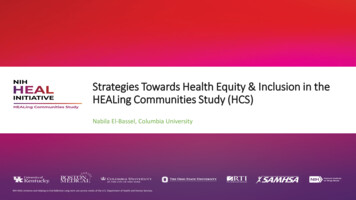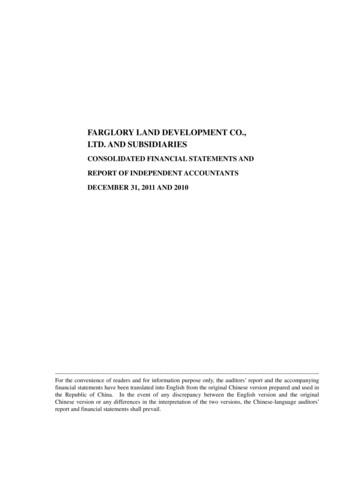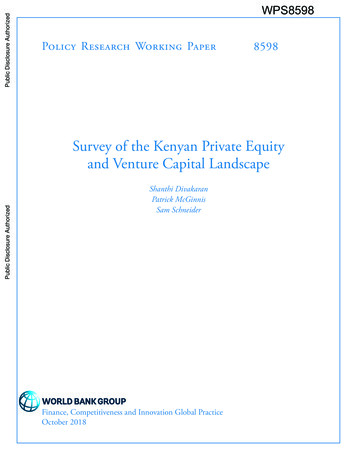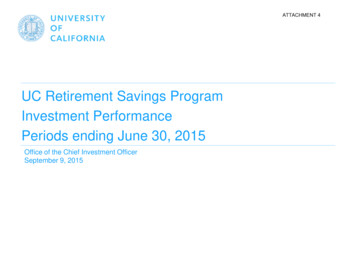
Transcription
Strategies Towards Health Equity & Inclusion in theHEALing Communities Study (HCS)Nabila El-Bassel, Columbia UniversityNIH HEAL Initiative and Helping to End Addiction Long-term are service marks of the U.S. Department of Health and Human Services.
Strategies Towards Racial/Ethnic Health Equity & Inclusion inHCSThis presentation covers: Introduction to the HEALing Communities Study (HCS) Definition of health equity & inclusion endorsed by HCS Implementation strategies towards health equity & inclusion in HCS Concluding remarksPRESENTATION TITLE2
HEALing Communities Study:Multisite parallel-arm cluster randomized waitlistcontrolled trial evaluating the impact ofCommunities That Heal (CTH) interventionImplemented in 4 states, 67 communitiesGoal: Reduce opioid-related overdose deaths by 40%in 3 yearsSecondary outcomes: Increase naloxone distribution Increase access/utilization of MOUD Decrease high risk opioid prescribingPRESENTATION TITLE3
HCS CommunitiesTotal HCS communitypopulationOpioid overdose deathrate (per 100,000)Number of communitiesby rural vs urbanMedicaid 62,357,1925,088,95633.438.240.628.327.529 rural38 urban7 rural9 urban5 rural11 urban8 rural8 urban9 rural10 urban--YesYesYesYes20% Black & LatinxPRESENTATION TITLE4
Health & Racial Equity Definitions endorsed by HCS Health care & addiction treatment -- like other systems in the US -- are steepedin a history of racism resulting in inequitable health outcomes among Black,Brown, Indigenous, & other people of color (BIPOC). Health equity is the provision of a fair & just opportunity for every person tobe as healthy as possible. This requires addressing stigma, discrimination,racism, & their consequences (Braverman, 2017).PRESENTATION TITLE5
National Data: Opioid-Related Overdose Death Trends byRace/Ethnicity 2010-2019, the overdose deathrates increased by 5-fold, (3.4 to17.3 overdose deaths per100,000) among Non-HispanicBlack population Tripled in the Latinx population(2.9 to 8.8 per 100,000) 2017-2019, the overdose deathrates remained steady amongNon-Hispanic White populations6
Opioid Overdose Death Rate Trends All HCS Communities by Race/Ethnicity, 2018-20192018502019Opioid overdose deaths increasedamong Non-Hispanic Blacks in the67 HCS communities from 20182019, & remained almost thesame for White & Hispanicpopulations45403538.339.541.730Fatal Opioid OD Rate(per 100,000, ages 18 )43.241.041.141.631.325201510507.5Total ic6.0OtherPRESENTATION TITLE7
Racial Inequities in Opioid Treatment Health care providers are more likely to prescribe Buprenorphine to a Whitepatient who uses drugs than a Black or Latinx patient who uses drugs Buprenorphine is more available in non-Hispanic White neighborhoods, whereasmethadone clinics are concentrated in non-Hispanic Black & Hispanicneighborhoods Among PWUD treated for a non-fatal overdose in an ED, Black & Latinx patientsare less likely to obtain a follow-up appointment for OUD care post-dischargeSources: Dayton et al, J Urban Health 2020; Lagisetty et al, JAMA Psychiatry 2009; Goedel et al, JAMA Network Open 2020;Kilaru, 2020, Austin et all, 2020.PRESENTATION TITLE8
Principles of Community-Based Participatory Research (CBPR)to guide our health equity missionHealth EquityFull participationInclusivity & representativeness of coalitions and CABTraining on cultural humility for researchers, coalitions and CABSustainability: Co-create sustainability plans with government officials that emphasize healthequity & inclusivenessData driven approach: On an ongoing basis, coalitions are provided with data to inform theirdecisions on deployment of EBPs through the portal, dashboard & data visualization
A Practical, Robust, Implementation &Sustainability Model (PRISM)CONTEXTUAL FACTORSEXTERNAL CONTEXTSocial Determinants of Health Poverty Racialized Drug Laws and PolicingFit & InteractionIssues:Shared agenda thatactively promoteshealth equity?Enablers & barriers toachieving healthequity?Culturally tailoredimplementation of EBPsto BIPOC & othermarginalizedcommunities?INTERNAL CONTEXT Diversity of stakeholders Integrate feedback of people w/lived experience Shared transparent decision-makingFit & Interactions among:RE-AIM(S)OUTCOMESCTH INTERVENTION &CARE CONTINUUM &COMMUNICATIONCOMPONENTS ON HEALTHEQUITYREACHEFFECTIVENESSOverarching Issues:Commonmeasurement onhealth equityindicators?ADOPTIONIMPLEMENTATIONSTRATEGIES & SYSTEMSCIENCE TOOLS FOCUSEDON HEALTH R & OUTER CONTEXTON HEALTH EQUITYDIMENSIONSCTH COMMUNITY ENGAGEMENT/SYSTEM CHANGE PROCESSESWho benefits fromthe interventions?
Examples of Strategies on Health Equity in CTH Expand MOUD & clinical services for non-English speaking patients Increase number of Spanish-speaking counselors & MOUD prescribers from Black,Brown, Indigenous, & other people of color (BIPOC) communities Increase the distribution of naloxone in communities of color & rural neighborhoods &settings Expand MOUD in rural communities by addressing the unique barriers they experience(i.e., transportation & lack of MOUD providers)PRESENTATION TITLE11
Communication Activities Focused on Racial EquityCampaign Materials Bilingual (English/Spanish)Tailored to their culture & languageCoalitions are encouraged to tailor their own imagesCoalitions develop distribution plans taking into accounttheir knowledge of the demographics (includingracial/ethnic composition)12
Consortium-wide & Site-specific Efforts on Health EquityConsortium-wide WorkgroupsPolicySocial Determinants ofHealth (SDoH)Site-specific EffortsRacial Equity &Social Justice (MA)Ensure racial/ethnicinequities in OUDCollect SDoH data that couldFederal & State Policy scanservices are addressedimpact implementation of2018/2019-presentCTH & outcomesResearch staff trainingon structural racismBlack Justice(NY)Expand diversity ofcoalitions to ensuremaximal representation ofunderrepresentedminoritiesMonitor & evaluate data toassess how interventionsmay disproportionatelyimpact BIPOC communitiesPRESENTATION TITLE13
Dissemination of Findings on Health Equity Publications in peer reviewjournals focused on health equity Presentations at conferences & forCABs, coalitions & stakeholders Dissemination of a monthly RESJnewsletter that highlightsresources & best practices relatedto advancing health equity (MA)PRESENTATION TITLE14
Concluding Remarks Racial/ethnic health equity & inclusion are integrated into thescientific process, implementation, & data of the HCS The process of advancing health, racial/ethnic equity & inclusion isevolving with multi-level collaborators The impact on health, racial/ethnic equity & inclusion aremeasured & monitored by HCS over time through primary &secondary outcomes & other measuresPRESENTATION TITLE15
HEALing Communities Study (HCS) . Racial/ethnic health equity & inclusion are integrated into the scientific process, implementation, & data of the HCS . measured & monitored by HCS over time through primary & secondary outcomes & other measures PRESENTATION TITLE 15. Title: Strategies Towards Health Equity & Inclusion in the HEALing .










